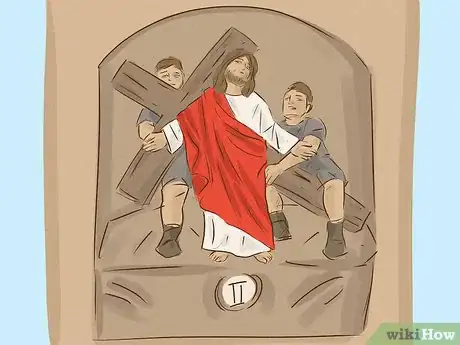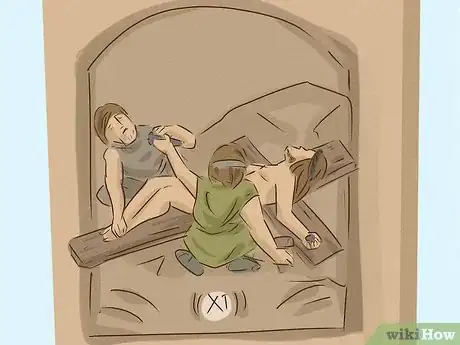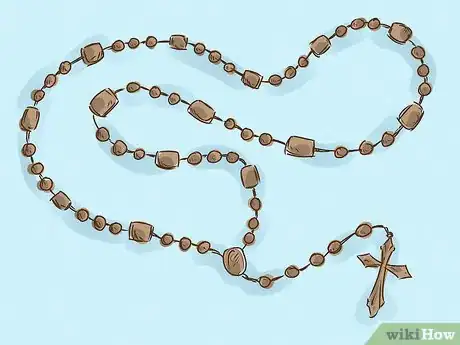This article was co-authored by wikiHow Staff. Our trained team of editors and researchers validate articles for accuracy and comprehensiveness. wikiHow's Content Management Team carefully monitors the work from our editorial staff to ensure that each article is backed by trusted research and meets our high quality standards.
There are 19 references cited in this article, which can be found at the bottom of the page.
This article has been viewed 32,314 times.
Learn more...
The Stations of the Cross are used in the Catholic and Episcopal Churches as a way to reflect on Jesus' crucifixion. Typically, you'll practice this prayer ritual most often during Lent, the 6 weeks leading up to Jesus' death and resurrection at Easter. The ritual consists of 14 stations that walk you through the crucifixion, which you can pray over on your own, during a church service, or with a guide. There isn't a standard prayer for each station, but you can find many examples in guides or talk to your priest about example prayers.
Steps
Meditating on the Stations at Home
-
1Focus on Jesus' being condemned to death. In this first station, reflect on the moment Jesus is sentenced to death by Pontius Pilate. Jesus doesn't try to defend himself, even though he didn't commit the crimes.[1]
- Typical prayers focus on beginning the journey to Calvary with Jesus, thinking of others who are suffering, and taking responsibility for your actions.[2]
-
2Think of Jesus receiving the cross. In the second station, Jesus begins to carry the cross. In some traditions, he carries the whole cross, while in others, it's just the transverse beam. According to tradition, he has already been whipped, so the burden of the cross increases that pain.[3]
- Here, you can reflect on Jesus taking up the cross in your place.
Advertisement -
3Fall under the cross with Jesus. The third station follows Christ as he takes his first fall. Though he is tired and wounded, he still gets back up and moves forward towards his Crucifixion.[4]
- Focus on Jesus' humility and willingness to be weak, acting on human strength alone. He fell, and with strength of will, got back up.
-
4Pray on Mary, the mother of Jesus. In this station, the fourth one, Jesus meets his mother along the road. She is distraught at what her son is suffering, covered in blood and carrying a heavy burden, yet she can't lift it from him.[5]
- Remember here that Jesus loved his mother very much, but even so, he doesn't stop or put down his burden.
-
5Lift the cross with Simon the Cyrenian. In the fifth station, Jesus faints from exhaustion and pain. Worried that Jesus might not make to the final crucifixion, the guards compel Simon to help him carry the cross. In the process, Simon becomes a follower of Christ.[6]
- Pray on how you can shoulder the burdens for others, too, and willingly so.[7]
-
6Attend to Jesus with Veronica. During the sixth station, Veronica wipes the blood from Jesus' face with a cloth and offers him wine to fortify him for the rest of the journey. It is said that his face left an impression on the cloth.[8]
- Focus on how you can offer service to Christ and to others in his name.[9]
-
7Fall with Jesus a second time. In this station, the seventh, Jesus falls a second time, once again due to exhaustion and pain. While Simon is still assisting, Jesus stumbles under the weight of the cross.[10]
- Pray on Jesus' willingness to continue suffering, despite the fact that he could have ended it at any time.
-
8Listen to what Jesus' says to the women of Jerusalem. Jesus meets a group of mourners on his way, the eighth station. Even as Jesus is suffering, he stops to comfort the women of Jerusalem, who are faithful followers.[11]
- Reflect on how you can listen to the pains of others and comfort them, even when you are suffering, too.[12]
-
9Stumble with Jesus a third time. In this ninth station, Jesus falls again. During this fall, Jesus is often portrayed as completely prostrate on the ground, a symbol that he has fallen into the dust, the same dust that God used to create Adam.[13]
- While the guards yell at Jesus, he still forgives them. Meditate on how he offers this forgiveness to you, and how you can offer forgiveness to others.[14]
-
10Humble yourself with Jesus as he's stripped of his garments. During the tenth station, the guards rip off Jesus' clothes, making his wounds bleed anew. The guards pour vinegar over his wounds and offer him gall to drink.[15]
- In this station, focus on Jesus' suffering and putting aside your own sinful nature.
-
11Feel Jesus' pain as he's nailed to the cross. This station is the eleventh. Jesus is placed on the cross, and the guards drive nails through his hands. Then, the cross is lifted up as the nail is driven through his feet.[16]
- Think on the suffering of Jesus and those watching, and pray on placing your sins on the cross, too.
-
12Pray on Jesus' death on the cross. During the twelfth station, Jesus dies on the cross after giving his spirit to God. Then a soldier pierces his heart with a spear.[17]
- Focus on how much Jesus suffers at this point, and yet, he still gives his spirit to God. Pray on the forgiveness he is offering in this act.
-
13Remove Jesus' body with his followers. After his death, Joseph and Nicodemus take his body from the cross in the thirteenth station. Mary, his mother, weeps over his body.[18]
- Reflect on this final act of Jesus: he wouldn't leave the cross until the final act of redemption had taken place, his death. Weep with his mother and his followers over his death.
-
14Lay Jesus to rest with his followers. For the final station, the fourteenth, Jesus' followers place his body in the tomb of Joseph of Arimathea. They roll the stone over the Sepulchre in anticipation of the Sabbath. During this time, it is said the Jesus goes to the realm of the dead. Called the Harrowing of Hell, Jesus redeems the souls of the just, taking them with him.[19]
- Focus on Mary's suffering, along with those of his followers. Think on how your sins got him to this humble ending, and how he paid that price for you.
Praying the Stations at a Church
-
1Read any material you're given at the beginning. Many churches will offer you a short guide to the Stations of the Cross before the service begins. Read through this guide to help you better understand what's about to happen.[20]
- Typically, there will also be an opening introduction and devotion.
-
2Listen to the religious leader announce each station. The leader will go station by station in turn. They will say what each station is, and then they will offer a short prayer or meditation.[21]
- Typically, you will be expected to respond as a group with the rest of the congregation, so look for the response in the material the church gives you. You just need to read it off.
- For instance, a response to the first station might be, "We adore you O Christ, and we praise you, because by your Holy Cross you have redeemed the world."[22]
-
3Expect to kneel and stand at different parts of the service. Typically, you will kneel for prayers on the kneeling rail in front of you. You may be asked to stand at other parts of the service, such as when hymns are sung.[23]
- You will likely be asked to kneel during the prayer portions of the Stations.
Using Guides
-
1Find a Stations of the Cross website for a visual guide. Some websites will take you through the 14 stations, usually with images and text. You can meditate on each image and say each prayer before moving on to the next one.[24]
- Don't speed through these websites. Take the time to focus on each image. Some websites even have short videos you can watch.[25]
-
2Go through the Stations on your own at a local church for more interaction. While local Catholic churches will have services, you can also go anytime the churches are open to pray on your own. During Lent, the Stations will likely be set up in the sanctuary.
- Start with the first Station and move through each one. Typically, there will be an image marking the station for you to reflect and pray on.
-
3Find a guided prayer in a Catholic prayer book for an at-home meditation. If you prefer to have more text, most Catholic prayer books will have a guided prayer on the Stations of the Cross. Simply follow the prayers in the book through the 14 Stations.
-
4Read through scripture focusing on the Stations for a scriptural prayer. Another way to pray through the stations is to read through a scripture guide. Each scripture will focus on one station, and you can pray on each one.[26]
- Your church may have a book you can borrow, or check your local library. You can also find scriptural guides online.
-
5Use a Stations of the Cross rosary to simplify the process. With this rosary, you pray on each bead as you normally would, but pictures of the Stations are interspersed throughout the rosary. As you come to each one, reflect on the station before moving on with the rosary.
- At each picture representing a station, think about the station and what it means. Pray on it.
-
6Listen to the Stations of the Cross if you want an auditory guide. Get a CD or MP3 download that walks you through the stations. You can even listen to it on your way home from work.
- Follow along carefully, praying on each section as you go.
References
- ↑ https://wau.org/resources/article/re_stations_cross_kids/
- ↑ https://www.crsricebowl.org/stations-of-the-cross
- ↑ https://csmv.co.uk/meditations/pray-the-stations-of-the-cross/
- ↑ https://ossory.ie/wp-content/uploads/2014/11/Stations-of-the-Cross-for-Our-Time-PDF.pdf
- ↑ http://www.scborromeo.org/prayers/soc.pdf
- ↑ http://www.scborromeo.org/prayers/soc.pdf
- ↑ https://ossory.ie/wp-content/uploads/2014/11/Stations-of-the-Cross-for-Our-Time-PDF.pdf
- ↑ https://ossory.ie/wp-content/uploads/2014/11/Stations-of-the-Cross-for-Our-Time-PDF.pdf
- ↑ https://wau.org/resources/article/re_stations_cross_kids/
- ↑ https://csmv.co.uk/meditations/pray-the-stations-of-the-cross/
- ↑ https://csmv.co.uk/meditations/pray-the-stations-of-the-cross/
- ↑ https://www.crsricebowl.org/stations-of-the-cross
- ↑ https://csmv.co.uk/meditations/pray-the-stations-of-the-cross/
- ↑ https://wau.org/resources/article/re_stations_cross_kids/
- ↑ http://www.scborromeo.org/prayers/soc.pdf
- ↑ https://csmv.co.uk/meditations/pray-the-stations-of-the-cross/
- ↑ https://csmv.co.uk/meditations/pray-the-stations-of-the-cross/
- ↑ http://www.scborromeo.org/prayers/soc.pdf
- ↑ https://csmv.co.uk/meditations/pray-the-stations-of-the-cross/
- ↑ https://bustedhalo.com/ministry-resources/why-i-stopped-avoiding-the-stations-of-the-cross
- ↑ https://bustedhalo.com/ministry-resources/why-i-stopped-avoiding-the-stations-of-the-cross
- ↑ https://ossory.ie/wp-content/uploads/2014/11/Stations-of-the-Cross-for-Our-Time-PDF.pdf
- ↑ https://www.episcopalchurch.org/library/glossary/way-cross-stations-cross
- ↑ http://www.resourcemelb.catholic.edu.au/object.cfm?o=196&pid=1390&showrm=true&uptam=false
- ↑ http://onlineministries.creighton.edu/CollaborativeMinistry/stations-how.html
- ↑ http://www.resourcemelb.catholic.edu.au/object.cfm?o=196&pid=1390&showrm=true&uptam=false



















































































